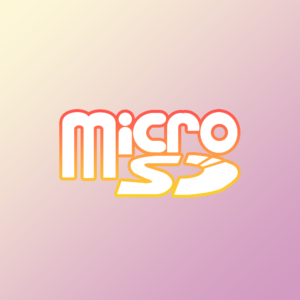 I’m a downloaded-media kind of guy. When I go on trips, it’s often to places which have spotty wi-fi, if any, so streaming is usually a no-go. A lot of the time I’m watching either on my phone or a cheap Kindle Fire tablet (I paid $29.99 a couple Black Fridays ago) via VLC.
I’m a downloaded-media kind of guy. When I go on trips, it’s often to places which have spotty wi-fi, if any, so streaming is usually a no-go. A lot of the time I’m watching either on my phone or a cheap Kindle Fire tablet (I paid $29.99 a couple Black Fridays ago) via VLC.
My Kindle Fire came with only 8GB of storage…but has 512GB now thanks to a MicroSD card.
(Yes, the card cost more than the tablet.)
Digital snobs like Apple and Google don’t have MicroSD card slots, but Amazon Kindle, Samsung Galaxy, and game systems like the Nintendo Switch do. I assume Apple and Google are just trying to get you to buy more expensive tablets.
If you’re in the market for a MicroSD cards, there’s really three key considerations.
Size
That’s up to you based on your needs. You can fit a ton of media on a 256, 512, or 1TB MicroSD. If you don’t mind switching cards in and out (and maintaining a list of what’s on which card), smaller capacities are cheaper. For example, check out these prices on the Sandisk Ultra A1 cards (Amazon as of this writing):
| Capacity | Price | Cents Per GB |
| 64GB | $10.97 | 17.1 |
| 128GB | $15.79 | 12.3 |
| 256GB | $19.99 | 7.8 |
| 512GB | $34.99 | 6.8 |
| 1TB | $109.89 | 10.7 |
So going from 128GB to 256GB is only a jump of 1.25x, but going from 512GB to 1TB costs you 3x!
This is similar to how spinning disk and SSDs are priced. Whatever is the most mainstream size is the cheapest per-GB/TB, and then if you want to move up to bleeding edge you pay a premium. At the low end, you pay more per-GB just because there’s a floor that reflects the cost to make any card, marketing costs, packaging, etc.
Manufacturer
I’ve always used either Sandisk or Samsung.
I got a pile of Samsung Evo 32GBs years ago and one has been powering my homemade Raspberry Pi digitial photo frame since 2018. Every hour, there’s about 10 minutes of intense I/O activity as pictures are selected, assembled onto backgrounds with ImageMagick, etc. so the MicroSD does get a workout. In that entire time, the card has performed flawlessly. I’ve been backing it up waiting for a failure but it just keeps working without an issue.
In the same timeframe, I’ve had several Sandisks in my Kindle Fire tablets (for me, kids, etc.) and they’ve all worked without issues.
There are others. Those are the two I use.
Application Performance Class
A1 is the older standard. It’s fine for things like hosting videos for playback, books, etc.
If your card is being used for applications (for example, you’re putting it in a Nintendo Switch), you’ll want an A2.
Here’s a comparison chart:
| Class | Max Random Read | Max Random Write | Max Sustained Sequential Write |
| A1 | 1500 IOPS | 500 IOPS | 10 MB/sec |
| A2 | 4000 IOPS | 2000 IOPS | 10 MB/sec |
As you can see, the difference is in the IOPS. Saving that JPEG your camera just took isn’t going to be different, but your game controller constantly grabbing game data is going to certainly appreciate A2.
Pick your size, pick your manufacturer, pick your class, and then start filling it up!























Leave a Reply